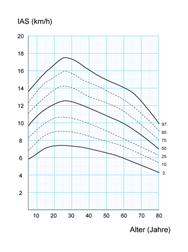| Ergonizer 30-day Trial Free Download |
|
| Our trial version is time limited to 30 days and restricted to a single test subject. | |
What is the "Anaerobic Threshold"?DefinitionIn the mid of the 20th century, K. Wasserman coined the term "Anaerobic Threshold" in terms of cardiopulmonary exercise testing. At these times, mainly gas exchange measurements have been used for the detection of the Anaerobic Threshold:
(K. Wasserman et al. 1964, 1986; Beaver et al. 1985)
Thereby, the essential benefit of this method was that subjects (e.g., severe sick patients) must not have been maximally exhausted during exercise testing. Blood lactate increase and CO2 exhalationThe "Anaerobic Threshold" as defined by Wasserman et al. can be determined from gas exchange by the onset of supplemental CO2-production (red arrow/left panel below)."Excess"-CO2 is described to be due to the increased lactate concentration and metabolic acidosis during exercise. Protones are buffered by bicarbonate what is releasing CO2 to the lungs (middle and right panel). This means that the "Anaerobic Threshold" by the concept of Wasserman et al., known also as "Lactate (Anaerobic) Threshold" or "LT" can be determined much more easily directly from the course of blood lactate than by the gas exchange measurements (Wasserman et al. 1986; Beaver et al. 1985, Roecker et al. 2000, Péronnet, F. et. al 2006). 
Sports scientific training guidance from blood lactate measurementsAfter Wasserman's innovation, the conceptual framework of the "Anaerobic Threshold" has been expanded from the pure diagnostics of performance to scientific evidenced training guidance and recommendations to improve aerobic training efficiency. This advancement was significantly influenced by the work group around Alois Mader, Wildor Hollmann and Hermann Heck in Cologne/Germany.Use of blood lactate measurements especially from capillary blood samples simplified application and reliability of metabolic training guidance fundamentally. From these times, however, some confusion came around about the term "Anaerobic Threshold": the original concept by Wasserman does not mean the same reference than many other measures or principles with partly the same or confusable names, but at much higher exercise intensities and blood lactate levels. 
Fixed or individual?As the anchor point for training guidances, fixed target levels (e.g., at 4.0 mmol/l blood lactate concentration) and on the other side, individual lactate levels have been introduced. While being a question of taste for the one, what concept is preferred for practical usage, some scientific work has shown that the individual concept for lactate increase during exercise has quite better predictive power for what you really want to know: the exercise performance of a subject.Several concepts for the determination of "Individual Anaerobic Thresholds" (IAT) have been developed, all with specific pros and cons (Tokmakidis et al. 1998). The best evaluated concept to predict endurance performance in different kinds of sports is the method of lactate net-increase above base line (Coyle et al. 1983). A variety of scientific studies relates to that method. Main important fact is thereby that this measurement is the best predictor known for sports specific performance (Roecker et al. 1998). Anyway, the term "threshold" turned out to be unfavourable recently, first because the physiologically justified (Wasserman-) threshold is far beyond practical endurance exercise intensities and second because so many different concepts are using the same term.
What is Ergonizer Software achieving for you?Blood lactate measurement is an easy task. But this applies not to the calculation of the "Individual Anaerobic Threshold" (IAT) and other measures from the lactate increase.The increase characteristics of blood lactate must be fitted against time or power output in terms of the so-called lactate-performance-curve. Manual creation and interpretation of these curves is not only troublesome, it's above all unreliable: Different investigators give different results if lactate curves are applied manually. An automated algorithm to generate lactate curve fittings has to be robust against little variations in the measurements to fit the real course of lactate increase optimally. Hence, main aspect of Ergonizer was, to create the best possible technical framework in the generation of graphically and mathematically realistic interpolations of lactate values during incremental exercise. The resulting test reports are the base of rock-solid training recommendations and performance measurements for many types of sports and other application areas. 
|
Switch languageenglish | deutsch | françaisFurther InformationExperience Ergonizer for yourself.
The latest information about new modules, add-ins, and updates. Stay in touch via Twitter: |
| Percentile function |

